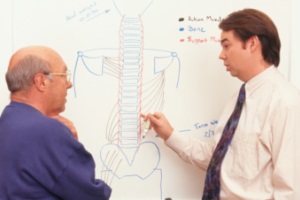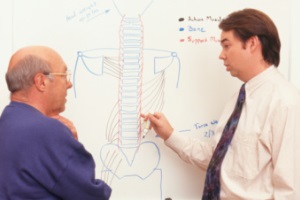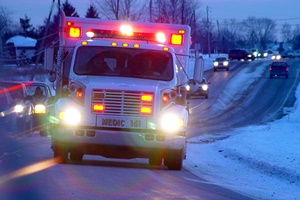Top Foods for Healthy Bones

Strong bones are essential for healthy living, but there’s no guarantee that any of us will have them as we grow up and grow older. While we don’t think about it very much unless something goes wrong, we need to do our part to develop and protect our bones. Proper nutrition is part of that.
Your skeleton is a living organ that needs nutrients in order to rebuild bone in areas where it is continually being broken down. Osteoporosis, a condition in which bones lose mass and density and are at greater risk for fractures, occurs in 55% of Americans over 50. Millions of fractures occur every year as a result of poor bone health.
The most common osteoporosis-related bone fractures among the elderly affect the hips, vertebrae, wrists and ribs. Vertebral fractures are the most common, and occur most often in women. You may see an elderly woman with hunched shoulders, head propped forward and unable to stand straight, because a few of her vertebrae have essentially collapsed. This condition is sometimes called “dowager’s hump”.
How do we prevent this from happening to us? In addition to regular weight-bearing exercise, diet can make a big difference. Here are some bone-friendly foods you can add to your diet to help keep your bones strong:
Seeds—Though we usually think of bones as being made of calcium, they also consist of other elements. For instance, half of the body’s magnesium is found in the bones. A great source of magnesium is seeds, particularly pumpkin seeds. Brazil nuts are also rich in magnesium.
Nuts—Walnuts are rich in alpha linolenic acid, which helps to keep bones building up instead of breaking down.
Leafy greens—Leafy greens (particularly the dark green kind), provide a host of nutrients and vitamins, including magnesium, calcium and vitamin K. Vitamin K helps to cut calcium loss in urine and is essential in building new bone matter to replace old.
Beans—Pinto beans, kidney beans, black beans and white beans all contain magnesium and even a little calcium. Beans not only help your bones, they help prevent obesity, heart disease and cancer.
Sardines—Canned sardines contain a substantial amount of calcium. A 3 oz. can typically contains 320 mg of calcium.
Swiss cheese—One ounce usually contains 270 mg of calcium.
Dried plums (Prunes)—Dried plums are a reliable source of dietary fiber, phenols and vitamin K. They’ve been shown to suppress the rate of bone resorption, or the breakdown of bone.
Besides eating well, it’s very important to remember to exercise. In fact, one of the greatest health risks faced by astronauts when they go into orbit is bone loss. Bones deteriorate more quickly in zero gravity unless exercise is included in the daily routine. The same idea applies here on earth. Stressing bones with physical activity (particularly weight-bearing exercise and exercise that involve some type of impact, such as running) seems to trigger bone-building activity and prevents the body from using bone-building nutrients for other things.



 According to the National Institutes of Health and Dr. Michael S. Wilkes of the Western Journal of Medicine, “Despite a plethora of research intended to guide physicians in their management of back pain, physicians still hold strong non-evidence based beliefs dating back to the 19th century.” What beliefs is Dr. Wilkes referring to? He’s talking about the long-held conventional wisdom that says bed rest is one of the best ways to treat back pain.
According to the National Institutes of Health and Dr. Michael S. Wilkes of the Western Journal of Medicine, “Despite a plethora of research intended to guide physicians in their management of back pain, physicians still hold strong non-evidence based beliefs dating back to the 19th century.” What beliefs is Dr. Wilkes referring to? He’s talking about the long-held conventional wisdom that says bed rest is one of the best ways to treat back pain.
 According to the National Institutes of Health and Dr. Michael S. Wilkes of the Western Journal of Medicine, “Despite a plethora of research intended to guide physicians in their management of back pain, physicians still hold strong non-evidence based beliefs dating back to the 19th century.” What beliefs is Dr. Wilkes referring to? He’s talking about the long-held conventional wisdom that says bed rest is one of the best ways to treat back pain.
According to the National Institutes of Health and Dr. Michael S. Wilkes of the Western Journal of Medicine, “Despite a plethora of research intended to guide physicians in their management of back pain, physicians still hold strong non-evidence based beliefs dating back to the 19th century.” What beliefs is Dr. Wilkes referring to? He’s talking about the long-held conventional wisdom that says bed rest is one of the best ways to treat back pain.
 America’s roads have become far safer across the past three decades. By just about any measure, travelers are much less likely to be injured or killed in a motor vehicle accident than they were in the late 1980s and early 1990s. And this is true even though we’re driving more miles each year!
America’s roads have become far safer across the past three decades. By just about any measure, travelers are much less likely to be injured or killed in a motor vehicle accident than they were in the late 1980s and early 1990s. And this is true even though we’re driving more miles each year!